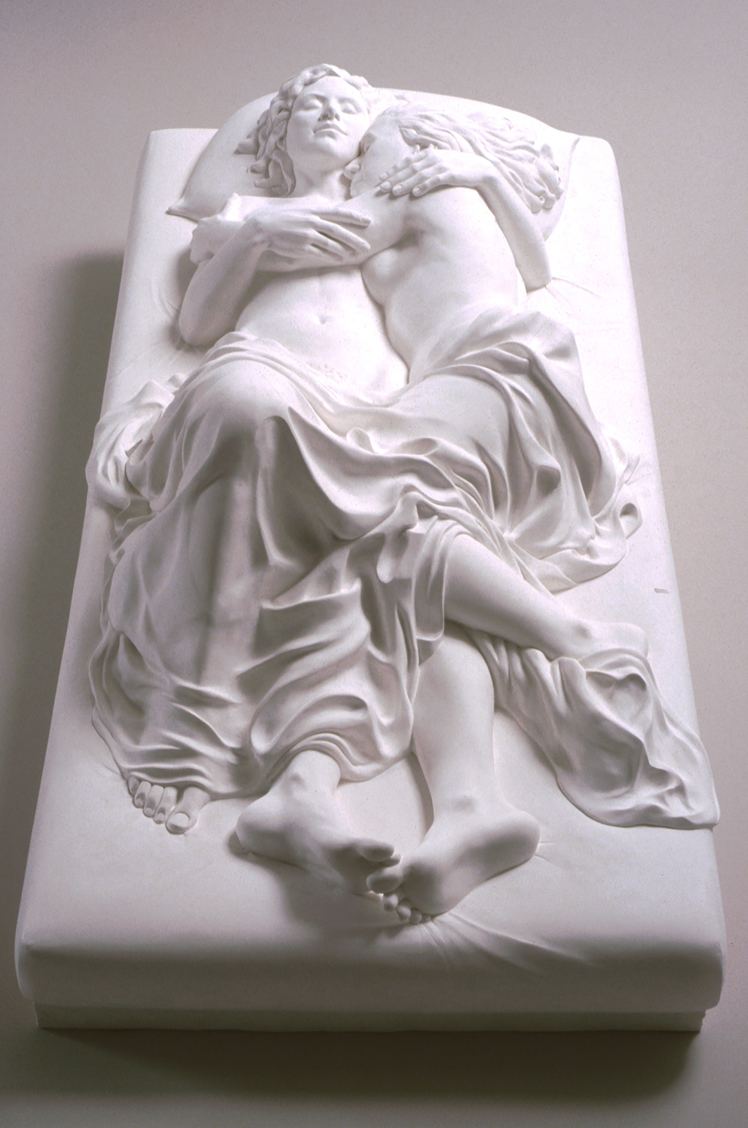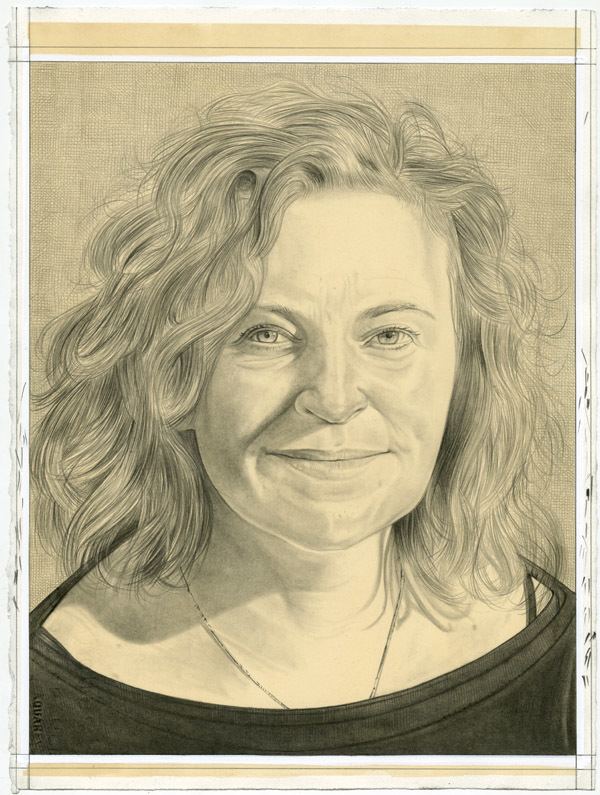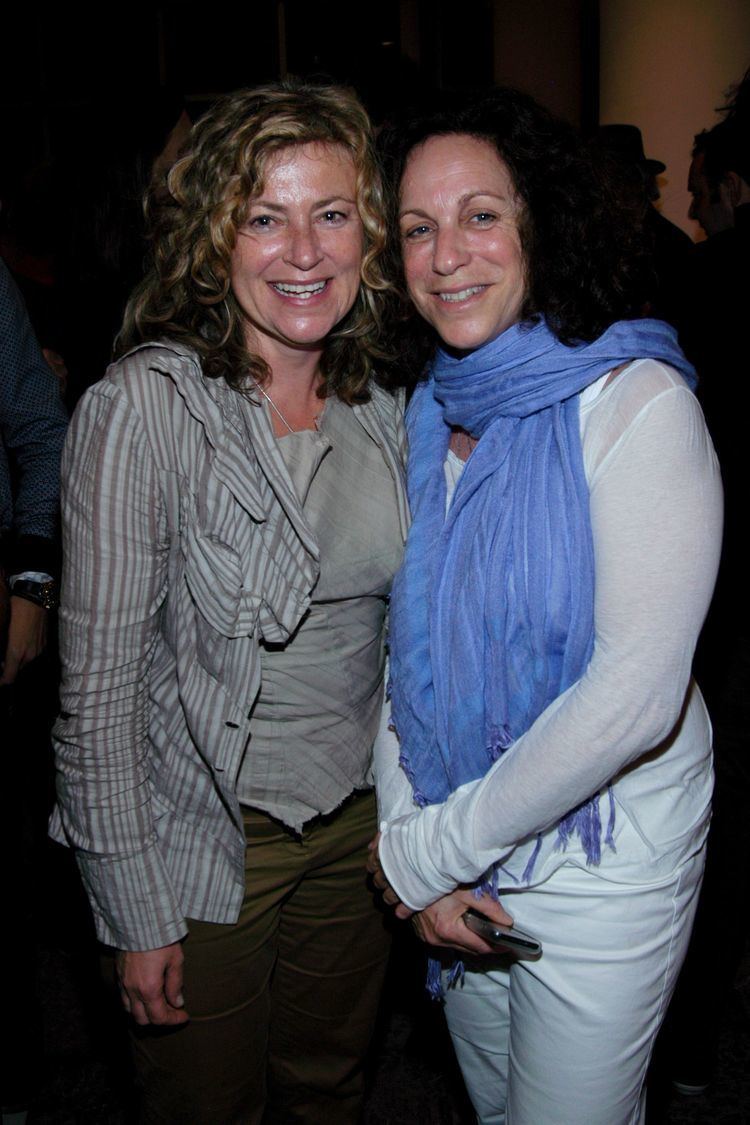Known for Painting, Sculpture | Role Visual Artist Name Patricia Cronin | |
 | ||
Awards Rome Prize from the American Academy in RomeCivitella Ranieri Foundation FellowshipLouis Comfort Tiffany Foundation GrantAnonymous Was a Woman Foundation AwardNew York Foundation for the Arts, Artist FellowshipPollock-Krasner Foundation Grant Books Zingmagazine #23, The Zenobia Scandal: A Meditation on Male Jealousy | ||
Interview with Patricia Cronin
Patricia Cronin, Yale Norfolk Art '85
Patricia Cronin (born in 1963 in Beverly, Massachusetts) is a New York-based cross-disciplinary artist. Since the early-1990s, Cronin has garnered international attention for her photographs, paintings and sculptures that address contemporary human rights issues. Cronin's conceptual artistic practice transits across many aesthetic platforms addressing social justice issues of gender, sexuality and class, including: lesbian visibility, feminist art history, marriage equality and international rights of women. She subverts traditional art images and forms in a wide range of two and three-dimensional time-honored artists' materials and breathes new life into these images and forms by injecting her specific political content. Slyly reinvigorating traditional images and forms with social justice themes, her critically acclaimed statue, "Memorial To A Marriage", a 3-ton Carrara marble mortuary sculpture of her life partner and herself was made before gay marriage was legal in the U.S., and has been exhibited widely across the country and abroad. Cronin began her career working for the Anne Frank Stichting (Foundation) in Amsterdam installing the traveling exhibition "Anne Frank in the World" in Europe and the U.S. Giving presence to female absence is a consistent thread that runs through and connects each body of work.
Contents
- Interview with Patricia Cronin
- Patricia Cronin Yale Norfolk Art 85
- Life and work
- Erotic Polaroids and watercolors 19921999
- Pony Tales and Tack Room 19961998
- Luxury real estate paintings 20002001
- Memorial To A Marriage 2002
- Harriet Hosmer Lost and Found 2009
- Dante The Way of All Flesh 2012
- Le Macchine Gli Dei e I Fantasmi 2013
- Shrine for Girls Venice 2015
- Shrine for Girls International Tour 20162018
- Notable Exhibitions
- Books and Films about Cronin
- References

Life and work

Cronin received her BFA from the Rhode Island College in 1986 and received an MFA from Brooklyn College in 1988 where she studied with Lee Bontecou and Philip Pearlstein. Cronin also studied at the Yale University Summer School of Music and Art, Norfolk Fellowship Program in 1985 and the Skowhegan School of Painting and Sculpture in 1991.

Cronin has had solo exhibitions at the American Academy in Rome, Musei Capitolini, Centrale Montemartini Museo, Rome, Italy, the Brooklyn Museum, Deitch Projects, and Brent Sikkema (now Sikkema Jenkins & Co.). Two survey exhibitions of her work have been organized; Patricia Cronin, The Domain of Perfect Affection, 1993 to 2003, UB Art Gallery, University at Buffalo, Buffalo, NY and Patricia Cronin, All Is Not Lost, 2000-2009, Newcomb Art Gallery, Tulane University, New Orleans, LA.

Cronin's work is in the permanent collections of the National Gallery of Art, Corcoran Collection and Smithsonian National Portrait Gallery, both in Washington, DC, Deutsche Bank, New York, NY, Perez Art Museum Miami, Miami, FL, The Gallery of Modern Art (GoMA) and Kelvingrove Art Gallery and Museum, both in Glasgow, Scotland.

Cronin is the recipient of numerous awards and grants, including the Rome Prize Fellowship in Visual Art from the American Academy in Rome, Louis Comfort Tiffany Foundation Grant, two Pollock-Krasner Foundation grants, Anonymous Was A Woman Foundation Award and the Civitella Ranieri Foundation Fellowship. Cronin has served as a Trustee on the Boards of the American Academy in Rome and the Civitella Ranieri Foundation. A frequent juror, currently she serves on the College Art Association's Artist's Lifetime Achievement Award.
Cronin has lectured extensively at many U.S. and international museums, including: the Victoria and Albert Museum in London, Kelvingrove Art Gallery and Museum, Glasgow, the Museum of Modern Art, New York, the Brooklyn Museum, Christie's, New York, Smithsonian National Portrait Gallery, Washington, DC, Museum of Fine Arts, Boston and the Venice Biennale, Venice. In 1994 she organized the panel "Lesbian Subjectivities" at The Drawing Center, New York, NY and guest edited the corresponding issue of Art Papers.
She has taught in the Graduate Art Programs at both Columbia University and Yale University and since 2003 she has been a Professor of Art at Brooklyn College of The City University of New York.
Erotic Polaroids and watercolors (1992–1999)
In these early works that blend performance and documentation, Cronin depicts the subject of explicit female sexuality in a way that both extends and critiques the role of sexuality throughout art's history. Curator Sandra Firmin observed, "in contrast to her contemporary, photographer Catherine Opie, who received critical acclaim for her dignified studio portraiture of queer leather communities in California, Cronin's snapshots are taken in the frenzy of participation. Emerging concurrently in the early 1990s, both Cronin and Opie offer a lesbian counterpart to Robert Mapplethorpe's controversial X Portfolio from the late 1970s and early 1980s, which filtered multiracial sex acts and sadomasochism through a highly disciplined language of formal photography, merging homoerotic pornography and high art in the process." These works give voice to a particular experience (that of Cronin herself whose vantage point as a participant is purposefully utilized throughout the work) while simultaneously speaking to larger questions regarding queer, lesbian or feminist subjectivities and the extent to which they are truly or accurately articulated and represented in artistic practice at large.
Boys and Girls from the Erotic Polaroid series were part of the exhibition Coming To Power: 25 Years of Sexually X-plicit Art by Women, which pays homage to the first generation of women artists who pioneered a new artistic genre in the mid-1960s and early 1970s using explicit sexual imagery and also presents the work of a younger generation of female artists that elicit sexual excitement as well as express autonomous pleasure, passion and pain. The exhibition was conceived by Cronin and fellow artist, Ellen Cantor, during their time at Skowhegan School of Art in the summer of 1991 and their collaboration on the project continued through 1993. The exhibition was later presented at David Zwirner Gallery curated by Cantor and sponsored by Simon Watson in 1993.
Pony Tales and Tack Room (1996–1998)
Cronin uses the "equestrian lifestyle" as a lens through which to see sexuality and class. In Pony Tales, Cronin interrogated the boundaries and possibilities of portraiture by focusing on a non-human subject, horses. Drawing inspiration from her own fascination with the species, as well as the popular literature and cult surrounding them, Cronin painted individual equestrian portraits that speak to how cultural fascination and fetishization create social values. Framed in walnut and installed on Schumacher's "Summer Country Archive" wallpaper, this body of work debuted at Sikkema Gallery, and was also shown at Real Art Ways, University of North Carolina at Chapel Hill, and UB Art Gallery at SUNY Buffalo.
Along with these portraits, an upper class equestrian socio-economic meilleure blending real estate and leisure lifestyle also inspired Tack Room (1997–98), an architectural environment where Cronin built a life-size stable complete with all the equestrian accouterments including: saddles, clothing and blankets. After closer viewing, the smell of leather and hay permeates the installation and suede chaps, leather bridles and metal bits, whips and paddles accumulated suggest a more sexual reading and open up Cronin's fantasy of what this kind of life might be like. The work was exhibited at White Columns and was one of the top ten shows of 1998 by art critic Lisa Liebmann in Artforum.
Luxury real estate paintings (2000–2001)
Continuing her interest in how cultural meaning is enshrined and propagated, Cronin turns her attention to the real estate market. This series depicts lavish, expansive and expensive homes and estates titled with the price and location of each estate (i.e., "$10,000,000 (Southampton)"). These small-scaled works, no larger than nine by fifteen inches, recall intimate real estate listings that ironically belie the actual expansion of the houses they advertise. Cronin used listings in Sotheby's International Realty as her source material, a conscious choice that raises questions about class and its relationship to fine art markets, controlled and regulated by auction houses like Sotheby's. The works were shown at Cronin's solo survey exhibition The Domain of Perfect Affection: 1993–2003 at the University at Buffalo Art Gallery in 2004 and in Looking At America exhibition at the Yale University Art Gallery, New Haven, CT, in 2002.
Memorial To A Marriage (2002)
In 2001, the Kansas City-based arts organization Grand Arts awarded Cronin an Artist's Project Grant to create Memorial To A Marriage, a three-ton Carrara marble mortuary statue of Cronin and her partner, the artist, Deborah Kass recumbent in an entwined embrace on a bed. As Institute of Contemporary Art, Boston former chief curator Helen Molesworth writes, the work "traffics in love and death, and in the intimate relations between these two structuring poles of human existence." Utilizing a nationalist form, American Neo-classical sculpture, to address a federal failure (the prohibition of gay marriage), Memorial to a Marriage balances visual poetry with political protest. Although now legal, today marriage equality remains an extremely contentious political and social issue in the United States.
Completed in 2002 when gay marriage was illegal in the U.S., the only legal protections available to gay and lesbian couples were about death; wills and health care proxies. Cronin created the marble mortuary statue of the two lovers, a decade before the Supreme Court struck down the Defense of Marriage Act in 2012. The art historian Robert Rosenblum described the work as "so imaginative a leap into an artist's personal life and so revolutionary a monument in terms of social history that it demands a full scale monograph." He named the installation as one of the ten best shows of 2003 in Art Forum.
With the help of Deitch Projects, Cronin purchased and installed the marble sculpture in 2002 on the couple's actual personal burial plot at Woodlawn Cemetery in the Bronx. Woodlawn was designed in 1863 as America's Pére Lachaise Cemetery and is one of the best examples of the nineteenth-century garden cemetery movement. It is the resting place for many historic figures including artists, writers, civic leaders, entrepreneurs, great entertainers and jazz musicians everyone from Elizabeth Cady Stanton, J.P. Morgan, Joseph Pulitzer, to Herman Melville and numerous mausoleums designed by architects McKim, Mead & White and John Russell Pope with Louis Comfort Tiffany and John LaFarge stained glass windows.
Memorial to a Marriage has been in 35 exhibitions, including the Brooklyn Museum, Palmer Museum of Art, Neuberger Museum of Art, Contemporary Arts Center in Cincinnati, and The FLAG Art Foundation, and is in several museum collections, including Smithsonian National Portrait Gallery, Washington, DC, Perez Art Museum Miami, Miami, FL and Kelvingrove Art Gallery and Museum, Glasgow, Scotland where it is on permanent view. Memorial to a Marriage has been written about extensively in many publications and also the subject in two Ph.D. dissertations as well as in and on the cover of Routledge's "Museums, Equality and Social Justice" book.
Harriet Hosmer: Lost and Found (2009)
Cronin won the Rome Prize for her series on Harriet Hosmer, an American expatriate who moved to Rome in 1852 and subsequently became known as the first professional woman sculptor The result of her research that year was the production of a catalogue raisonné for which Cronin took on the roles of historian, artist and curator as she herself compiled art historical research on Hosmer, illustrated the book with her own watercolors and wrote descriptions of each work.
As Maura Reilly, founding curator of the Elizabeth A. Sackler Center for Feminist Art at the Brooklyn Museum, writes, Cronin's complex role as an artist raises questions such as "in choosing a female artist, one who was famous in her day yet relatively unknown today, Cronin's deconstructivist project diverges from her previous interventionist project, Memorial To A Marriage. With the Hosmer project she is highlighting instead the canon of art history's exclusions and inclusions, thereby figuring forth its discriminatory practices and sexist foundations that make it acceptable for certain artists – male – to be raised to the canon's heights and others not."
The catalogue combines hand painted images with art historical research to create a document that reveals the complexities of Hosmer's career, reputation, and legacy. Hosmer moved to Rome in 1852 and lived among a community of British and American artists and writers and a circle of learned and well-to-do "independent women." Hosmer had an important career, was praised by critics, won competitive commissions, and earned enormous sums for her sculptures. In this unique catalogue, Cronin pieces together a conceptual framework to examine the histories of art and women at the intersection of the ivory tower and the marketplace.
This is particularly evident in Cronin's handling of the works for which visual images does not exist. In these cases Cronin's depicts, not a physical likeness, but its suggestion, what art historian Alexander Nemerov describes as ghosts and Cronin herself calls "phantoms." In these moments of absence the viewer is made aware of the built in impossibility of the project which, with these watercolors, become part of its subject and thus speaks directly to the legacy of feminist art and its implication in contemporary artistic practice.
The work was exhibited at the Elizabeth A. Sackler Center for Feminist Art, Brooklyn Museum in 2009-10. Reviewing the show in The New York Times, Pulitzer Prize winning art critic Holland Cotter wrote, "In short, Ms. Cronin's Hosmer show – organized by Lauren Ross, interim curator of the Sackler Center – is a complex package: a total work of art that is also a historical document of the careers of two artists, past and present, and a salvage operation to secure the visibility of both artists over time."
Dante: The Way of All Flesh (2012)
Cronin's ongoing relationship to Italian art history and literature has continued past her Rome Prize year at the American Academy in Rome. Looking at the global financial crisis and conflict areas, Cronin felt a need for a new humanism, which she has integrated into her artistic practice. Cronin turned to Dante Alighieri's Inferno as a point of departure for a series of expressive figurative oil paintings, watercolors and bleach portraits of corrupt politicians and religious leaders. The series shows her expanding on recurring themes – whose life has value and who decides, church or state – while simultaneously drawing on the classic work to elaborate on Dante's allegorical timeless story of a cautionary tale largely gone unheeded. Elizabeth Kley writes in Artnews, "Untitled (2012) is a 16-part grid of watercolors created by bleaching red and orange paper. Inspired by Dante's lineup of named Renaissance malefactors, they are portraits of contemporary power mongers who've committed the sins that Cronin (and Dante) consider most heinous; fraud, treachery, and betrayal."
Le Macchine, Gli Dei e I Fantasmi (2013)
For her 2013 exhibition (Machines, Gods and Ghosts) Cronin was the first contemporary artist invited to use the historic venue at the Musei Capitolini's converted powerplant Centrale Montemartini Museo in Rome and re-conceptualize many of the concerns of her earlier work. Conceived specifically for the museum's Engine Room, this industrial archaeology commingled with the Capitoline Museums' Classical sculpture collection and the "phantoms" or "ghosts" from Cronin's Hosmer project. Using a 21st-century printing technique, dye sublimation enlarged on silk, these panels hung throughout the space slowly undulating, these new pieces further highlight the evocative juxtaposition of anachronic pairings of classical sculptures and their modern surroundings and in their contrasting materiality and formalism, underscore questions of absence and omission as they relate to the history, art and civilization including the anonymous artists that carved the Classical marble sculptures and the anonymous missed workers who are no longer employed at the power plant. If Cronin's work on Harriet Hosmer asked the important question of who and what gets remembered in Art History, then this newest project stresses how contemporary art might also be utilized to ask this same question. The show was accompanied by a catalogue, published by Silvana Editoriale, with essays in both Italian and English written by Peter Benson Miller and Ludovico Pratesi.
Shrine for Girls, Venice (2015)
Shrine for Girls, Venice is a solo Collateral Event of the 56th International Art Exhibition – la Biennale di Venezia 2015. Inside the sixteenth-century Church of San Gallo, this dramatic site-specific installation focuses on the global plight of women and girls, often facing violence, repression and forced ignorance, and is a shrine in their honor. Shrines, part of every major religion's practice, provide a space for contemplation, petition and rituals of remembrance. Here, Cronin gathered hundreds of girls' humble clothes from around the world to reference specific tragic events in India and Nigeria, as well as, the United Kingdom and the United States, and arranged them on three stone altars to act as relics of these young martyrs. Juxtaposing brightly colored saris like those worn by gang raped and murdered girls in India, muted palettes of hijabs worn by the students kidnapped by Boko Haram in Nigeria and ghost-like values of aprons from the Magdalene Laundries in the UK and US with the richness of the marble and wood paneled church interior opens up a space for refuge and reflection in the face of human tragedy. Shrine for Girls, Venice proposes a new dialogue between gender, memory and justice. Julie Belcove writes in the Financial Times, "The pared-down presentation demands quiet reflection, and the piece's emotional power, Cronin hopes, will derive from viewers' intuitive comprehension of what is absent."
Shrine for Girls, International Tour (2016–2018)
After the Venice presentation, Shrine for Girls began an international tour at The FLAG Art Foundation, New York (June 9 – August 12, 2016). "Moving from the marble alters and sacred architecture of Venice's sixteenth-century Chiesa di San Gallo to the secular gallery context of FLAG, Cronin will present the same three fabric sculptures, here piled on top of their shipping crates to now address human trafficking as well as human rights issues. The installation of clothing, of what the missing bodies would have inhabited, provokes an emotional and visceral response to what is absent. Small photographs of each tragedy accompany the sculptures and provide very real context for the work. A new series of watercolor portraits place a human face on tragedy and amplify the 'identifiable victim effect,' drawing our attention away from statistics to the magnitude of the individual loss and unrealized human potential." The wide-reaching impact of Shrine for Girls is evidenced by its inspiring the fashion label Tome's Resort 2017 collection.
Shrine for Girls is to then travel to India, Nigeria, and Ireland – the locations of the events that inspired the work – through 2018. Moving from the sacred to secular architecture the work courses within the architecture of the powerful providing a stark contrast with her subjects, the powerless.
